Coordinating digital product development is challenging. Especially if a project is large and involves many simultaneous processes, multiple stakeholders, resource limitations, and tight deadlines. Mistakes in coordination might lead to broken deadlines, financial losses, low code quality, and dissatisfied stakeholders or users.
A wisely chosen software development methodology can respond to these risks. The right methodology will allow your teams and stakeholders to establish clear, consistent processes and communication, increasing the chances of successful software delivery.
Each methodology addresses particular challenges, meets specific needs, and has its own limitations. Your project managers should consider multiple variables before making a choice. Keep reading to find out what factors influence the choice of a software development methodology and the best approach to managing your own project.
This article will be useful for IT project leaders who want to set up a development process that perfectly aligns with their project needs and minimizes the risks of miscommunication, delays, and quality issues in the final product.
What is a software development methodology, and why does it matter?
A software development methodology is a framework that allows a software development team to plan and manage the software development process.
Project leaders use software development methodologies to structure and organize software development activities, communication, and software delivery. A methodology also helps with assigning roles to participants in the development process. Thus, stakeholders and team members can know their responsibilities, how to handle emerging risks, whom to contact and when, and how to stay on the same page.
Because a software development methodology serves as the backbone for the whole development process, its absence or lack of fit may lead to consequences such as:
- Scope creep due to a lack of control over changes
- Poor communication and a mismatch between stakeholder expectations and the delivered product
- Broken deadlines
- Cost overrun
When choosing the right software development methodology according to your project requirements, you not only avoid the issues mentioned above but also increase the chances of your project’s success. Let’s take a closer look at the benefits you can get from the right software development methodology:
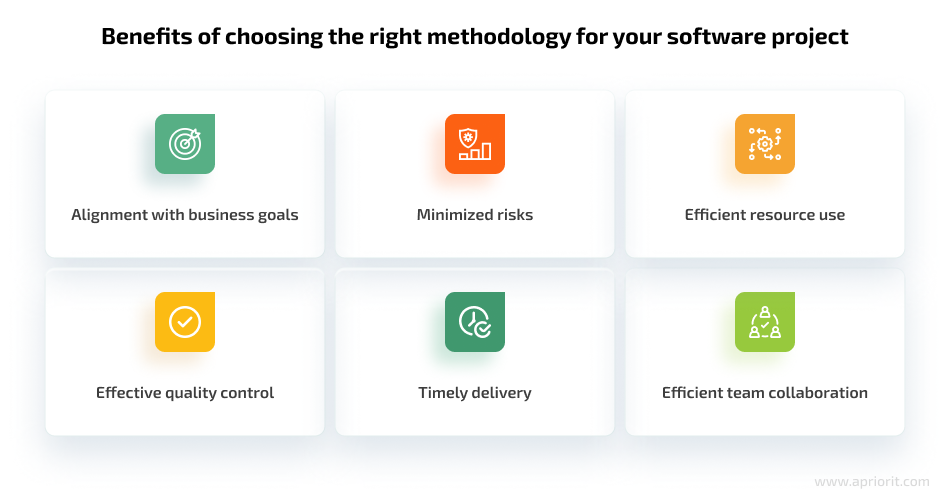
- Alignment with business goals. Different methodologies allow you to prioritize different business goals, such as fast time to market, flexibility, or the need to deliver a project on a tight budget. Tailoring a methodology to your goals allows you to achieve the desired result and maximize the chance of your project’s success.
- Minimized risks. An appropriate methodology can help you identify and mitigate risks such as requirement changes, integration problems, and technical challenges early in development.
- Efficient resource use. The correct methodology ensures that resources like time, money, and team availability are used efficiently. It can also ensure your team doesn’t do unnecessary work or deliver features that won’t bring value to your users once the project is delivered.
- Effective quality control. Some methodologies emphasize regular reviews and testing in your workflow. As a result, you get a thoroughly tested, high-quality product.
- Timely delivery. The right methodology can help you evaluate project needs and constraints and schedule the project delivery accordingly so that your project is completed on time.
- Efficient team collaboration. A suitable methodology establishes clear roles and responsibilities within your team, keeping everyone motivated and structured with a clear workflow and goals.
As you can see, a software development methodology can make or break your project, so it’s important to choose it carefully. In the following section, we discuss the main software development methodologies we use at Apriorit to deliver projects successfully.
Focus on your business goals and leave operational issues to us
Get your software product delivered on time and within budget. Leverage Apriorit’s 20+ years of experience in software development and project management.
3 major types of software development methodologies
There are dozens of software development methodologies for projects of different sizes and with different goals, budgets, and teams. Based on our experience completing hundreds of projects, we’ve listed three top software development methodologies that are time-tested and effective. Let’s explore their approaches to development, what advantages they can bring to your project, and what you should consider before choosing them.
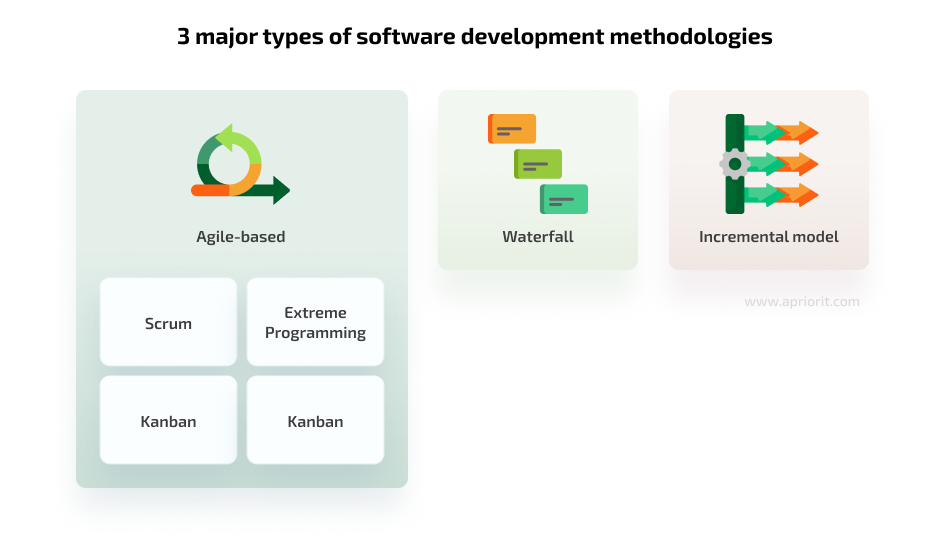
1. Agile-based methodologies
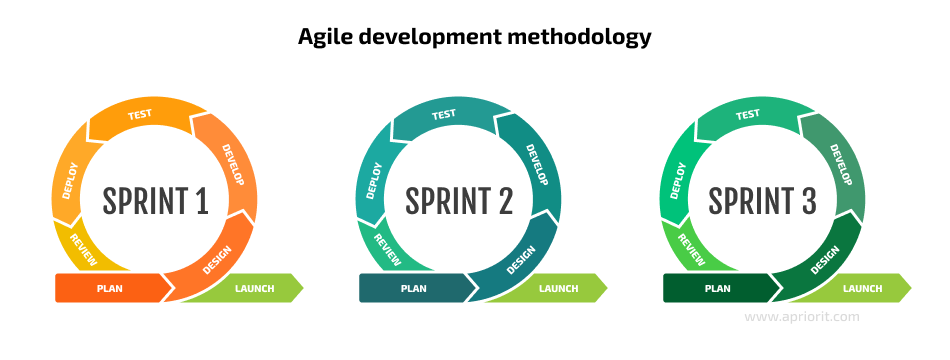
Agile software development methodologies emphasize team flexibility and speed, along with transparency in work processes. Agile principles include:
- Ongoing product improvement through iterative work cycles
- Continuous client feedback, effective communication, and collaboration
- Focus on delivering working software that meets user needs
- Flexibility and ability to respond to changes
In Agile, work is divided into short cycles called sprints, which typically last two to four weeks. During each sprint, the team develops and tests a specific set of features. Each sprint begins with a planning meeting, during which the team selects items from the product backlog — a prioritized list of work to be done — based on their importance and the team’s capacity.
| Pros | Cons |
|---|---|
| Quality assurance happens regularly and is integrated into the development process | Lack of a clear project development plan and challenging to estimate the final scope |
| Products reach the market fast, allowing for a quick return on investment | Constant risk of reworking large parts of the project |
| The user experience is researched and refined at all stages | Potential decline in product quality due to the emphasis on speed and simplicity |
| Development is transparent for both stakeholders and the team | Continuous communication may reduce work efficiency |
| Reduced risk of project failure | |
| Adherence to deadlines |
Suitable for:
- Technologically complex and multifaceted projects
- Long-term projects
- Projects where the number of ideas exceeds the team’s capacity
- Projects with high client involvement
- Projects with significant levels of uncertainty or dynamic target markets that change frequently
Many software development methodologies are based on Agile principles:
- Scrum focuses on iterative development. It divides the project into small, manageable sprints, each aiming to deliver a potentially shippable product increment. It’s most suitable for complex projects with evolving requirements, such as software products that need regular updates and improvements.
- Extreme Programming (XP) promotes high-quality software through frequent releases in short development cycles, incorporating best practices for efficient software development. It’s ideal for technically challenging projects that require high-quality code and frequent releases.
- Kanban focuses on visualizing the workflow, managing work in progress, and improving efficiency. It’s flexible and allows teams to continuously deliver value without being tied to fixed sprints. Kanban is best for projects that require a flexible and continuous workflow, such as maintenance projects or long-term projects with many ongoing tasks.
- Feature-Driven Development (FDD) focuses on delivering tangible, working features that bring immediate value to the client. FDD is suited for large-scale enterprise projects with well-defined and stable requirements, emphasizing client value.
Read also
Agile and Hybrid Approaches to Kernel and Driver Development: Pros, Cons, Examples
Discover how to customize Agile and hybrid methodologies to deliver high-quality kernel and driver development projects on time and within budget.

2. Waterfall
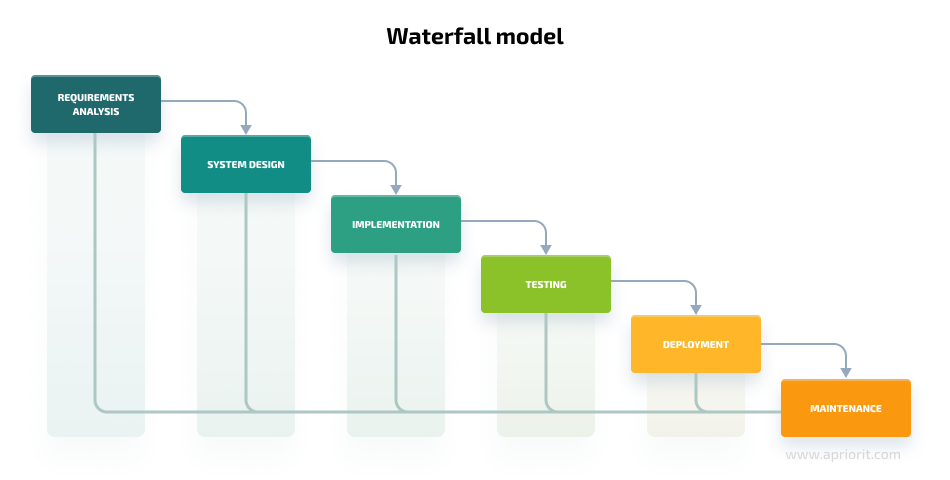
The Waterfall development methodology is a traditional and straightforward way to build software. It has a linear top-to-bottom structure, where every stage has its distinct goal. Developers must complete a stage fully before moving to the next one, and at the end of the Waterfall project, you get a finished product.
| Pros | Cons |
|---|---|
| Full documentation of each stage | Requires full approval of system requirements at the beginning |
| Precise planning of timelines and costs | Low flexibility in project management |
| Process transparency for the client | Late detection of problems |
| Definite and clear steps in the workflow | Client cannot verify the product’s quality until the entire development process is completed |
Suitable for:
- Small to midsize projects with clear, unchanging requirements
- Building a product similar to ones previously developed by the team
- Migrating from one platform to another
- Creating and releasing a new version of an existing product or system
- Projects where testing is handled by the client
- Projects with low stakeholder involvement
Read also
No-nonsense Project Communication Management: Benefits and Practical Examples
Establish efficient communication that leads to success. Learn about the two most important communication tools in software development and ensure you and your team are moving towards a common goal.

3. Incremental model
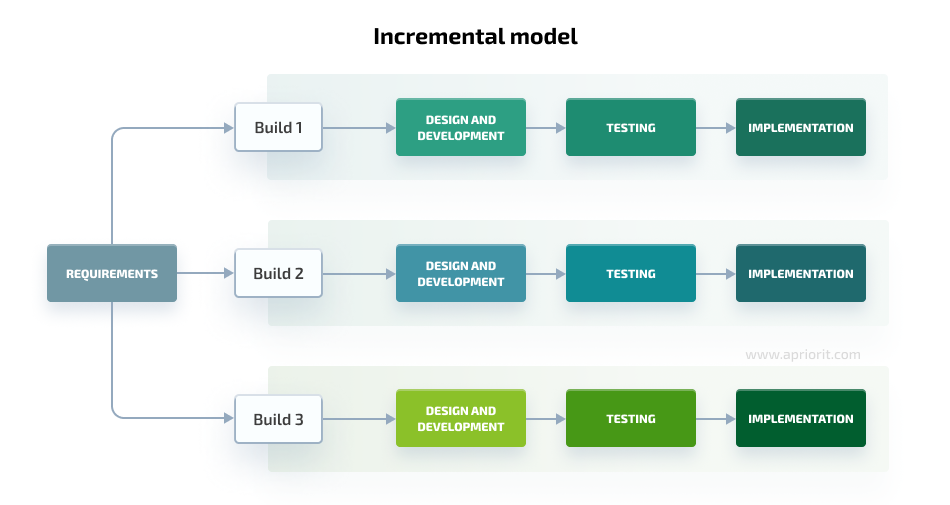
The Incremental model follows a similar structure to the Waterfall model, but each stage is repeated multiple times throughout the software lifecycle. It can be described as a multi-waterfall approach.
The process starts by implementing a basic software version with planned features. Stages include analysis, design, programming, testing, and product release. With each repeating cycle of stages, the team improves and expands the project until it achieves the intended functionality.
Compared to the Waterfall model, the Incremental model lets you see results earlier and make further decisions: adjust requirements, develop a more advanced product, or release the first version as your MVP.
| Pros | Cons |
|---|---|
| Can launch the product quickly to field-test the idea | The initial app version may be released without all the planned features |
| The initial software version is highly cost-efficient | Can be difficult to make quick changes to software requirements |
| Easy to manage risks due to regular iterations | Changes in software versions aren’t well-documented due to rapid development |
| Costs can grow due to repeated cycles of planning and design |
Suitable for:
- Early product launches
- Projects with clearly defined system requirements that need few changes
- Projects with risky features or goals
- Modular systems
- Projects with high stakeholder involvement
Now that we’ve discussed the main software development methodologies, their pros and cons, and suitable applications, let’s explore the factors you should consider to make the right choice for your own software development project.
How to choose the right software development methodology for your project
To choose the perfect software development methodology for a specific project, you need to consider at least seven core factors:
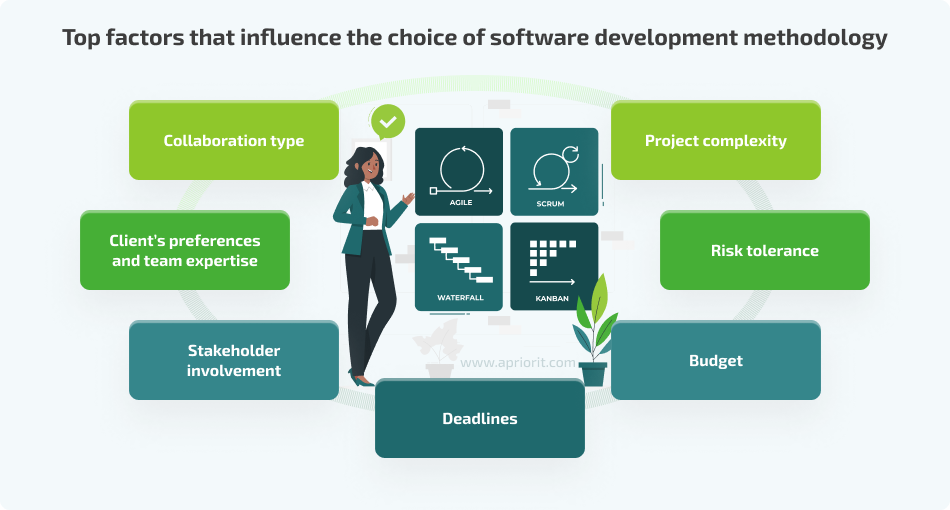
Project complexity
Projects can be complex in many ways:
- Size and scope. Large projects with a broad scope, numerous features, and multiple components generally require structure and scalability.
- Technical challenges. Projects that use rare technologies or have intricate architectures must focus on regular testing, continuous integration, and technical excellence.
- Uncertainty. Projects with frequent changes or unclear end goals will benefit from regular reassessment and adjustments.
The methodologies that satisfy these demands come from the Agile family due to their flexibility and iterative approach:
- Extreme Programming (XP) allows you to focus on technical aspects by fostering test-driven development, pair programming, and continuous integration. Frequent releases and constant refactoring help to achieve high code quality and minimize errors.
- Scrum enables effective management of complex projects through iterative development and regular feedback. By breaking the project into manageable sprints, your team can handle evolving technical requirements and ensure continuous reassessment.
- Kanban offers flexibility and continuous delivery, making it ideal for projects with shifting technical priorities. With Kanban, your team can visualize the workflow and limit work in progress so they can manage complex tasks more efficiently.
Tips from Apriorit’s experience: One of our projects involved a remote-access solution with Windows API drivers and hooks. We needed to debug an extensive, aged codebase to resolve conflicts with various end-user applications and the latest Windows versions.
To succeed, we addressed each issue individually, prioritizing them by severity. We chose the Kanban methodology to handle priorities (which were shifting multiple times a week) and to perform complex bug evaluations that required extensive research. This approach allowed us to effectively adapt to frequent priority changes while handling complex issues.
Read also
Tips and Tricks for Mastering Risk Management in Agile Software Development
Our client wanted to enhance VAD platform security and performance by adding new capabilities to their platform and needed quality support for existing features.

Risk tolerance
When starting a project, software development teams need to account for many risks such as:
- Unforeseen technical issues
- Miscommunication
- Misalignment with stakeholder expectations
- Scope creep
- Regulatory non-compliance
The choice of methodology depends on what risks are most likely to occur in your project, which will depend on its complexity and unique circumstances.
In particular, you can pay attention to:
- Stakeholder expectations — If you want to avoid unforeseen issues and ensure stakeholders get exactly what they expect from the final product, consider the Waterfall methodology. Its structured phases and well-defined requirements create a clear roadmap. Extensive documentation also makes Waterfall beneficial for projects where regulatory compliance is critical.
- Quality requirements — To avoid technical risks like bugs and integration issues, consider Agile-based methodologies like Kanban, XP, or Scrum. These methodologies promote regular testing and iterations. They also help avoid the risk of missing the market by constantly assessing feedback and enabling the team to pivot in response to new market demands or business goals.
By understanding the specific risks associated with your project, you can select the best software development methodologies to mitigate them and ensure successful delivery.
Budget
Budget restrictions influence the choice of methodology, as each methodology offers different approaches to predicting costs and allocating resources. The more budget restrictions your project has, the more structured your methodology should be.
The Waterfall approach offers the necessary structure and predictability to provide a clear picture of the budget and timeline, but you need to account for other factors like the project’s complexity and size for an accurate estimate.
Apriorit’s experience: When clients come to us with a proof of concept (POC) or a minimum viable product (MVP) request, we usually recommend the Waterfall methodology. MVPs and prototypes typically have strict budgets, as stakeholders want to field-test their ideas without significant investments or raise money by demonstrating a working concept.
Waterfall allows us to thoroughly gather and estimate requirements and create a clear plan that puts necessary limits around the scope and, subsequently, the budget.
In some cases where Waterfall isn’t suitable because of the size of the project but budget considerations are still a priority, we can recommend an Incremental methodology. It allows you to break down the project into manageable increments. Thus, you can roll out the first version of the product during the first increment and gradually improve it increment by increment as your budget permits.
Deadlines
If your project has tight deadlines, your methodology should be about prioritization, manageability, and fast testing so you don’t sacrifice quality for speed.
Agile-based methodologies and the Incremental model allow you to divide the project into small parts and quickly test and deliver them. The Incremental model is perfect for quick releases, as it allows you to build and release the first version of the product quickly and go through cycles of improvement as long as necessary after the product is already on the market.
Apriorit’s experience: One of our projects involved creating a tool for backing up media from various devices to an external USB device. To accelerate the product’s launch and generate early returns for our client, we adopted an Incremental model.
First, we implemented the photo and video backup feature for Windows and macOS desktop computers and launched the product. This enabled users to access core features immediately. We then developed a module for backing up music and other files, following the same process. Finally, we expanded support to iOS and Android mobile devices.
Using the incremental model allowed us to quickly deliver essential features, meet tight deadlines, and ensure early profits for our client.
Related project
Supporting and Improving Legacy Data Management Software
Discover how Apriorit specialists improved user satisfaction with our client’s legacy system by improving its supportability and preparing it for migration to a new platform.
Stakeholder involvement
Stakeholder involvement influences communication, decision-making, and overall project success, so it’s important to choose a methodology that matches the level of impact stakeholders are willing to make.
Agile-based methodologies like Kanban, XP, and Scrum are designed for high stakeholder involvement. They focus on collaboration, feedback, and frequent communication during daily meetings, retrospectives, planning meetings, and reviews.
These methodologies ensure stakeholders have continuous input and visibility into the project’s progress, leading to more accurate requirements and higher satisfaction with the final product.
In contrast, methodologies like Waterfall require lower stakeholder involvement. Because the Waterfall model is highly structured and allows for minimal changes, as a stakeholder, you only need to provide detailed requirements at the start, approve major milestones, review the product after each phase, and perform final acceptance testing.
Apriorit’s experience: At Apriorit, we offer several specialists who act as bridges between the development team and stakeholders. A project manager ensures the team understands and prioritizes stakeholder requirements, while a business analyst works with stakeholders to gather and document detailed requirements.
As a stakeholder, you can provide continuous feedback, attend review and planning meetings, help prioritize and approve features and functionalities within sprints, or minimize your involvement in the project.
Collaboration type
The collaboration type you choose when partnering with your software development vendor can also influence your choice of methodology. Different collaboration models, such as fixed price, dedicated team, and time and materials, have certain characteristics that align with specific methodologies.
- Fixed price. You decide on the project scope, timeline, and budget before work begins, which is suitable for small projects with well-defined requirements and few anticipated changes. The best methodology for this collaboration model is Waterfall due to its detailed upfront planning and documentation. The Incremental methodology can also suit the fixed-price model by dividing the project into separate, well-defined increments with a fixed-price contract for each.
- Dedicated team. You get a team of developers assigned exclusively to your project. This model is flexible and can work with any software development methodology.
- Time and materials. You pay for the actual time and resources spent on the project and can make many changes according to your product’s evolving requirements. Agile-based methodologies like Scrum, Kanban, and Feature-Driven Development are well-suited for this model, as their flexibility accommodates changing scopes based on new market or user requirements.
Client’s preferences and team expertise
You may prefer a particular methodology because of your organizational culture or experience. This is especially true when you hire an external team to power your in-house resources to speed up delivery or access unique expertise.
If you or your in-house team has a preferred methodology, adapting to it can streamline communication and productivity, reduce learning curves, and increase the likelihood of success.
Apriorit’s experience: We have extensive experience collaborating with in-house teams, as clients often hire us for our unique expertise. Our team adapts to a client’s existing processes to ensure seamless collaboration. If our client’s team doesn’t have a preferred methodology, depending on the project, we offer to follow collaboration-centered methodologies from the Agile family, like Scrum or Kanban. Their emphasis on regular communication and transparency ensures that our team and our client’s team are on the same page and working towards a common goal..
Read also
How to Efficiently Organize and Manage a Distributed Software Development Team
Learn how to gather and lead a team of top experts from all over the world so they deliver the best results for your business.

Taking a hybrid approach to managing software development
If you feel like none of the methodologies fully matches every aspect of your project, you can opt for a hybrid approach. By combining aspects of different software development approaches, you can better address particular requirements of the project at hand. There are three main ways to integrate a hybrid approach to project management.
- Combining Scrum and Kanban for parallel workflows
This involves using different methodologies for various tasks within the same project. If you need to maintain the structure in project activities but have an ongoing flow of high-priority tasks that are hard to plan into fixed sprints, you can use ScrumBan — a combination of Scrum and Kanban.
For instance, your team can develop new features critical for market entry using Scrum to ensure planning and regular delivery. At the same time, bugs reported by end-users can be addressed using Kanban for rapid resolution and frequent commits. This ensures the development team can promptly handle high-priority tasks while maintaining a structured release schedule.
Apriorit’s experience: In one of our projects, we had regular releases every one to two weeks with must-have features scheduled for each release (Scrum), while bug fixes for critical issues raised by customers were handled using Kanban. This dual approach allowed us to maintain a reactive and flexible development process, which is crucial for meeting tight deadlines and ensuring high customer satisfaction.
- Combining Waterfall and Scrum to handle different aspects of a project
In some cases, a single project may require a blend of methodologies to handle different phases or aspects of development. For instance, you can combine Scrum’s iterative planning with Waterfall’s long-term budgeting and timeline planning. This method allows you to stay flexible in development while maintaining a clear view of the project’s overall scope and deadlines.
Apriorit’s experience: In another project, the client required extreme flexibility to accommodate new and undefined features while also needing long-term budget planning. To meet these needs, we combined the Waterfall and Scrum methodologies. We estimated features and budgeted upfront using Waterfall, but we kept the project flexible with iterative two-week sprints that are typical of Scrum. This combination ensured that we could efficiently manage both immediate customer requests and long-term project goals.
Conclusion
As software development projects become more complex and the market becomes more demanding, it’s paramount to set up efficient development processes. Applying the right software development methodology can help you minimize unnecessary work, budget overruns, and broken deadlines.
To choose an appropriate development methodology, you need to consider many factors, such as your project’s needs, size, complexity, timeline, and the level of uncertainty you expect. If you are unsure what methodology to choose, we can help.
Apriorit has over 20 years of experience successfully delivering projects of varying sizes and complexities. You can be sure that our project management experts will set up the best possible process for your project so that you can focus on your business goals and achieve them with a high-quality product.
Looking for a team you can rely on?
Our experienced managers and developers know how to build a delivery process based on your project’s unique needs.




